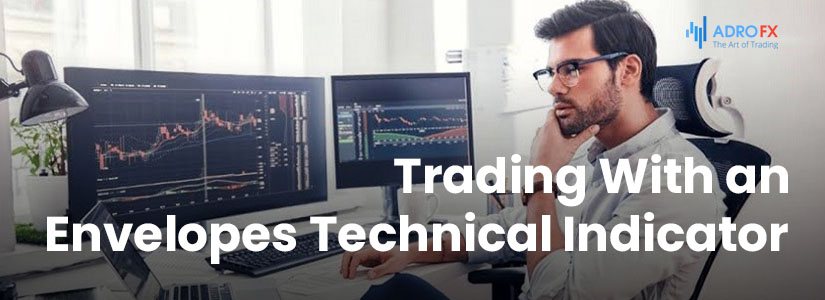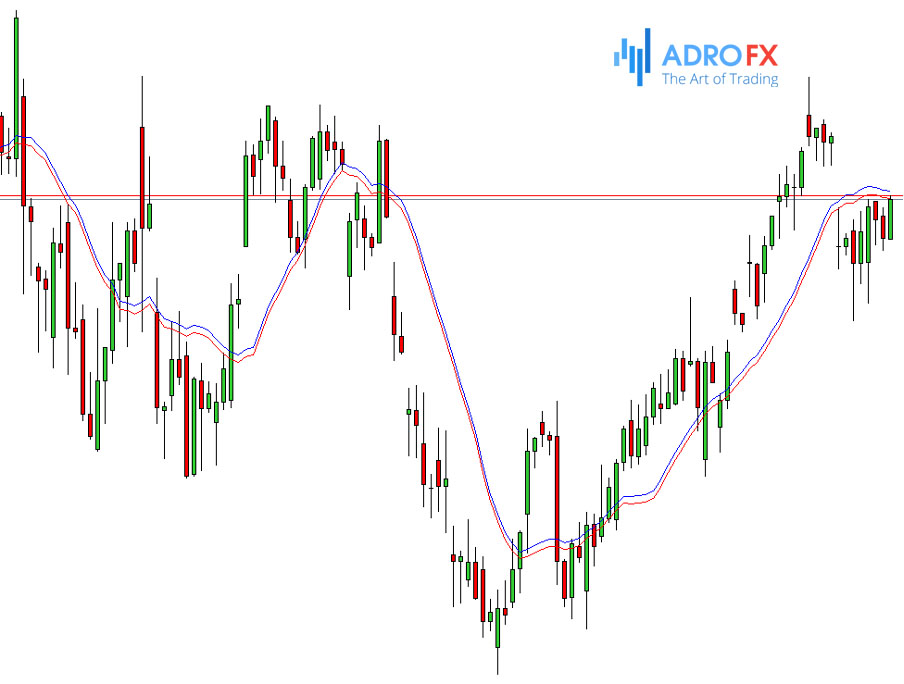Trading With an Envelopes Technical Indicator

The Envelopes technical indicator is one of the simplest indicators when in forex trading and is included in the list of tools on classic platforms. This indicator is based on the observation that after the price rises or falls, it returns to the main trend in any case.
Description
The Envelopes indicator is designed to form price channels by chart movement. In addition to the basic function, there are additional functions - detecting the direction of market trends, as well as notifying the user of the upcoming correction or change in the main trend. In this indicator, the boundaries of the formed channel will be the lines of Moving Average.

Most traders believe that this indicator is an analog to another indicator, namely the Bollinger Bands. The interface of these two indicators is indeed similar. In addition, they both form a price channel. But in fact, they have several differences, which shows that they are not "twins".
The basic idea behind all of the work with the indicator in question is as follows. The price chart moves within a particular channel, sometimes leaving it. If the chart goes out of the borders, then almost all traders close positions, fixing profits. It follows from this that the chart is unlikely to stay long outside the lines that limit the price channel, and soon it returns to that local price range, while (possibly) changing the direction of its movement.
This indicator forms price channels using two Moving Average lines. In the indicator settings, you can specify the type of Moving Average used in the calculations. Each type will have its own specifics of working.
The Moving Average lines, which are the boundaries of the price channel, are located above and below the tangent of the Moving Average middle line, which has an offset coefficient of fourteen. It is important to understand that this coefficient is given as a percentage. The higher the ratio is, the farther apart the price channel borders will be and the less the number of signals will be, but the quality of the signals will improve considerably.
Moving Average with the period of 14 is the central line of the price channel on the chart.
This indicator has a significant disadvantage - it senses the market noise very strongly and does not consider the volatility of the market in its calculations. Some traders use not Moving Average, but Average True Range (ATR) to solve this problem. This method is effective and increases the number of quality trades.
The Envelopes indicator has a number of adjustable parameters. Among them: period, which determines the range of price values, based on which the middle Moving Average is calculated, on the basis of which the lines-borders of the price corridor are constructed. The longer the period, the slower indicator reacts to price changes. The lower the period, the faster reaction, but the higher the number of false signals.
The next parameter is the channel width, which is determined by the deviation of lines from the middle Moving Average. It is considered that a deviation above 2% is excessive, as the indicator generates too many false signals. Such parameter as indicator shift shows the shift of Envelopes lines by time. If the shift is set as a positive number, the shift is directed forward, if negative, then it is directed backward. This parameter should soften the signal lag, which is typical for Moving Average indicators.
The trader selects the indicator values so that the price indicators were as accurate as possible, i.e. the rebounds from the price channel levels should not cause any doubts. Besides, price movements should stay within the price channel as long as possible and break out of it only during the real trend change.
Pros and Cons of the Envelopes Indicator
The indicator has the advantage that it has no ambiguity in interpretation. The advantage of the indicator is the exact definition of the flat movement and the moment when the flat movement ends. This allows you to trade within the channel without excessive stress pressure. Another advantage of the indicator is its simplicity and that it is easy to program and write an Expert Advisor for automated trading based on it.
The disadvantages of the indicator are that it generates a lot of false signals during strong price movements and that its signals are lagging so the indicator is not particularly effective.
How to Set Up an Envelopes Indicator?
This tool is built-in and can be found on any trading platform, so you do not have to install it. To make the indicator appear on the chart, you need to do the following: in the "Insert" section, select the "Indicators" subsection. In the next menu "Trend" find the desired indicator and click on it.
After performing the above steps, the Envelopes will appear on your work screen, and with it the settings menu for this indicator. That is, your working indicator window will look as shown in the screenshot above.
Let us have a look at the parameters that can be adjusted:

"Deviation" is the main coefficient that helps to adjust the distance between the price channel boundaries concerning the Moving Average middle line. The optimal option will be to set a value of no more than two percent.
"Apply to" – this parameter is responsible for the distance between the boundaries of the price channel and the real working chart.
"MA Method" – this parameter sets the type of lines, which are the boundaries of the price channel. It can be either Simple, Exponential, Smoothed, or Linear Weighted.
"Shift" – this parameter is responsible for the distance between the instrument boundaries and the patterns. It is recommended to leave this parameter unchanged.
"Period" is the parameter, which is responsible for the number of candlesticks, which will be used when calculating the indicator. If you set a smaller value for the period, you will get more signals, but their quality will be noticeably lower. And vice versa, the higher the period, the signals will be of higher quality, but their quantity will be drastically reduced.
In addition to the above settings, you can customize the appearance of the indicator.
The indicator has preset parameters of the period, deviation, shift, and type of MAs. Traders work mainly with these parameters, but they can be changed. Parameters are set depending on currency pair and time frame, the trader determines the correct parameters empirically.
Envelopes Indicator Readings
The signals of the indicator under consideration are not complicated. For example, the indicator shows a signal about the possibility to place a trade when the price breaks out the boundary of the corridor. After the breakout, it is waiting for the price to return to the channel, after which the trade can be opened. That is, in fact, the trades are opened after two breakouts of the channel.
The interpretation of the signal must consider the direction of the channel movement. Accordingly, if the channel is moving upward, the signals are expected from the bottom line marking the channel. If the channel is moving downward, the signals are tracked from the upper border.
When the price reaches the upper limit, a sell trade is opened, when the price reaches the lower limit, a buy trade is opened. These signals are most clearly identified during a flat movement, but trading will be more effective when a clear trend is formed. Envelopes signals can be monitored without additional indicators and oscillators, but it is better to combine it with other indicators to confirm and refine signals.
Envelopes-Based Trading Strategies

Envelopes strategies are not very popular in forex trading, as they are not very different from other strategies, based on Moving Averages. Certain rules should be followed when using the indicator: price movements should be analyzed in half an hour time frame minimum, optimally on H1, because it is difficult to determine a false or true signal in less extended time frames. But some strategies can be implemented in lower time frames.
When working with the Envelopes indicator on a candlestick chart, it is recommended to open orders only after the close of the candlestick, indicating a reversal inside the price channel. In this case, almost all candlesticks must be inside the price channel. If all of the subsequent candlesticks on the chart close above or below the crossed Moving Average, this indicates that the breakout is turning into a trend.
There are several basic strategies for trading with the Envelopes indicator. When working with the indicator, the upper line is regarded as a resistance level, while the lower line is regarded as a support level.
The first strategy is used for short-term trades and is based on price movements within the price channel. The second strategy is based on the moments of the breakout of price channel borders. With any strategy of using the Envelopes indicator, the result will be obtained with additional indicators.
Another strategy is a momentum strategy, in which the entry is made on a strong price spike, which is confirmed by the indicator. The trader waits for a breakout on the momentum and trades using it.
Another strategy involves a combination of Envelopes and Bollinger Bands. The Bollinger Bands indicator is installed in the trading terminals among the standard tools.
The strategy is implemented in the H1 time frame, on the candlestick chart, on the EUR/USD pair.
We need to configure both indicators. Suppose the parameters for Envelopes are as follows: indicator period: 200, shift: 1 to close prices, deviation: 0.15, line: Simple.
Parameters of Bollinger Bands may be: period: 20, shift: 0, deviation: 2, also by close prices.
As a result, the chart will look like this. You may also add some variants of the Moving Average to the chart for more accurate orientation within the channel boundaries.
The long position is supposed to be opened at the moment when the bull candlestick crosses the upper line of the Envelopes indicator in the direction from below to above. The candle should close, and the trade is opened on the next candle. Bollinger Bands allow you to determine the location of a Stop Loss, which is placed behind the line of the Bollinger indicator.
The short position is placed after a bearish candlestick crosses the bottom line of the Envelopes indicator from top to bottom. The trade is closed when the candlestick closes and the next one is formed, confirming the trend. Stop Loss is placed behind the Bollinger Band indicator line. Pay attention that this strategy is not recommended for use in a highly volatile market.
Another strategy is based on the interaction of Envelopes and the Stochastic oscillator, which allows you to determine the entry point.
This methodology is suitable for trading when the price is moving within a range, alternately bouncing back and forth from the upper and lower boundaries of Envelopes.
You will need a standard Stochastic to confirm or deny the Envelopes signals. When the price rebounds from the boundary of the indicator, a position should be opened either up or down. It is best to trade in a 15-minute time frame at least since both indicators tend to lag a little behind price, which may be critical when operating below M15.
Add both indicators on the chart, and leave the settings as standard. Ensure that Stochastic levels are at 20 (oversold) and 80 (overbought).
You can trade any currency pair at your discretion. The main thing is that a certain price channel is outlined on the chart, between the boundaries of which the price moves.
Then we wait for the moment when the price rebounds from the boundaries of Envelopes, and if Stochastic confirms the signal, we open a new position.
Let us consider an example of opening a long position:
- The price has bounced from the lower boundary of the Envelopes indicator.
- Stochastic has left the oversold area, for which the level of 20 is responsible.
- We open a buy trade after the signal candlestick closes.
- Take Profit is placed at the opposite border of the Envelopes channel.
- Set Stop Loss outside the lower border of the channel, from which the price rebounded.
- To place a short position we need the following conditions:
- The price has rebounded from the upper border of Envelopes.
- The Stochastic oscillator has moved out of the overbought area, for which the 80 level is responsible.
- We place an order as soon as the signal bar closes.
- We place a fixed Take Profit on the lower border of the band.
- Stop Loss is placed beyond the upper boundary, from which the price has rebounded.
This is a scalping strategy and can bring good profits, provided that all rules for finding entry points are followed.
Conclusion
Envelopes is one of the standard indicators in forex trading terminals. It represents two lines forming a price corridor, all price movements occur within this corridor.
Traders wait for the indicator to show that prices approach the bounding lines and trade on the return of the price to the boundaries of the corridor. It is recommended to complement the Envelopes indicator when trading with other indicators and oscillators, it may increase its efficiency.
There are many strategies based on this indicator, which are in principle based on the same principles, that is why these strategies are not that different. But they are quite simple in their application. At the same time, when working with Envelopes, it is important to properly adjust the indicator to avoid signals becoming too rare or, on the other hand, too many false signals. The efficiency of the indicator's work should be confirmed by preliminary testing.
About AdroFx
Established in 2018, AdroFx is known for its high technology and its ability to deliver high-quality brokerage services in more than 200 countries around the world. AdroFx makes every effort to keep its customers satisfied and to meet all the trading needs of any trader. With the five types of trading accounts, we have all it takes to fit any traders` needs and styles. The company provides access to 115+ trading instruments, including currencies, metals, stocks, and cryptocurrencies, which make it possible to make the most out of trading on the financial markets. Considering all the above, AdroFx is the perfect variant for anyone who doesn't settle for less than the best.










